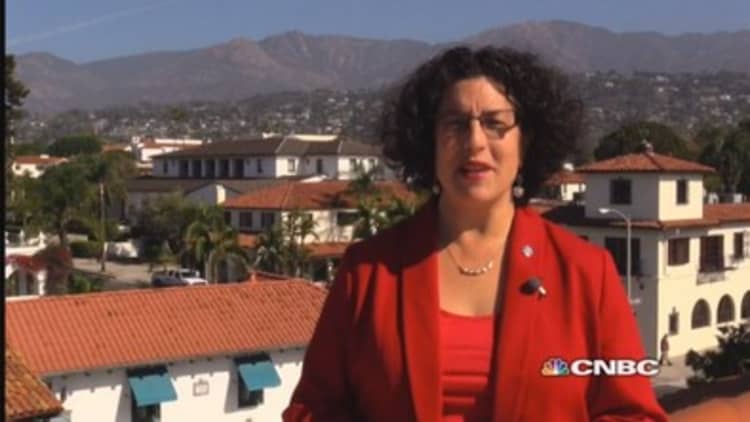
California boasts the eighth-largest economy in the world and technology prowess that helped develop—among many other things—desalination in the 1950s. The Golden State also has more than 800 miles of coastline with limitless supplies of seawater from the Pacific Ocean.
But a combination of economic, environmental and regulatory hurdles remain before widespread use of desalination can be fully realized and help make a dent in the drought-stricken state's water shortage.
"Ocean desal is pretty expensive still," said Ellen Hanak, senior fellow at the San Francisco-based Public Policy Institute of California and director of the Institute's Water Policy Center. "It's probably the most expensive single source that an urban agency can use, but its advantage is it can be reliable, since there's a lot of ocean water out there."
Read MoreDrought puts screws on California's swimming pools
Experts say the energy-intensive process to remove salt from ocean water means desalination water can cost double the amount of water that comes from recycling wastewater or building new reservoirs. What's more, the cost to build and operate desalination plants is high, and the state of California is unlikely to fund all such projects, although several affluent coastal cities such as Santa Barbara and Cambria have moved forward with plans of their own.
"Energy is a major cost component of a desalination plant," said Heather Cooley, water program director for the Pacific Institute, an Oakland-based non-profit that focuses on water issues. "And so the cost of energy has a major impact on the cost of water that's proposed."
Currently, seawater and brackish water desalination is estimated to contribute less than 1 percent of California's drinking water. The most common desalination used in the state is not from seawater but from brackish groundwater that's processed in desalting plants located in some of the state's largest urban areas.
Read More Outside states to California dairy farmers: We have water
Currently there are more than 20 operating groundwater desalting facilities statewide. At last count, there were another 16 groundwater desalination plants proposed or in the works, according to California Department of Water Resources.
How it works
Two main desalination techniques are used today: reverse osmosis membrane and thermal distillation technologies. Reverse osmosis is a process whereby salt is removed from water using filtration. The thermal technique essentially involves boiling water, capturing the evaporation, and then condensing it into drinking water.
Desalination is not new to California, and some of the reverse osmosis technology was developed in the state during the 1950s. The first major desalination facilities were operating by the 1960s for non-potable uses such as cooling coastal power plants.
"We have seen the cost of desalination come down over the past 15 to 20 years, in part due to improvements in the (reverse osmosis) membranes," said the Pacific Institute's Cooley. "Most people generally think the plants are as efficient as they're going to get and as low a cost as they're going to get out of seawater desalination."
Read MoreUnsafe water only adds to California drought misery
A state report found seawater desalination facilities using reverse osmosis can expect to see as much as half of their total annual costs come from energy consumption; and if energy prices go up that figure could increase.
The nation's largest desalination project is under construction in Carlsbad, California, and it uses reverse osmosis technology. The plant cost nearly $1 billion and will provide about 50 million gallons of water daily, or about 7 percent of San Diego County's water needs.
A spokesperson for Poseidon Water, the company behind the Carlsbad facility, said the plant is on track to deliver water this fall. However, before the privately financed project broke ground in 2012, it had endured six years of government permitting and more than a dozen lawsuits by environmentalists.
'Two big problems with desalination'
"There are two big problems with desalination. One is the cost, and the other is the environmental impacts on the near-coastal zone where you have to flush the brine water that is the residual of the desalination," said Henry Vaux Jr., professor emeritus of resource economics at the University of California in Riverside. "The salinity is much higher than the customary salinity of seawater, and that has adverse effects on the near-coastal zone environment."
Opposition from the Sierra Club and several other environmental groups is one reason that a proposed desalination plant in Huntington Beach has been delayed. Poseidon Water, the Boston-based firm that's developing both the Carlsbad and Huntington Beach projects, defends the Huntington Beach development as safe for the environment. It's hoping to secure necessary approval this year from the California Coastal Commission to begin construction of the plant.
Read MoreAmid drought, California farmers near 'survival mode'
The state agencies may be more receptive to desalination projects. In announcing the record low Sierra Nevada snowpack last week, California Gov. Jerry Brown issued an executive order for state agencies to "streamline government response" during the drought emergency to projects that increase local water supplies, including desalination plants and water-recycling facilities.
The order also called for "accelerating use of cutting-edge technologies such as renewable energy-powered desalination."


